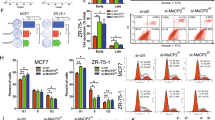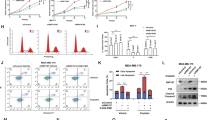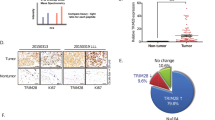Abstract
Although previous studies suggested that the tumorigenicity of mouse double minute 2 (MDM2) was due to its negative regulation of p53, the p53-independent interactions may be equally as important. During recent studies utilizing MDM2 inhibitors, we noted that E2F transcription factor 1 (E2F1) was downregulated upon inhibition of MDM2, regardless of the p53 status of the cancer. The present study investigated the mechanisms responsible for the MDM2-mediated increase in E2F1 expression. MDM2 prolongs the half-life of the E2F1 protein by inhibiting its ubiquitination. MDM2 displaces SCFSKP2, the E2F1 E3 ligase. Direct binding between MDM2 and E2F1 is necessary for the negative effects of MDM2 on E2F1 ubiquitination, and deletion of the MDM2 nuclear localization signal does not result in loss of the ability to increase the E2F1 protein level. The downregulation of E2F1 upon MDM2 inhibition was not due to either pRB or p14Arf. In addition, E2F1 was responsible for at least part of the inhibition of cell proliferation induced by MDM2 knockdown. In conclusion, the present study provides evidence that stabilization of the E2F1 protein is likely another p53-independent component of MDM2-mediated tumorigenesis. More knowledge about the MDM2–E2F1 interaction may be helpful in developing novel anticancer therapies.
This is a preview of subscription content, access via your institution
Access options
Subscribe to this journal
Receive 50 print issues and online access
$259.00 per year
only $5.18 per issue
Buy this article
- Purchase on Springer Link
- Instant access to full article PDF
Prices may be subject to local taxes which are calculated during checkout







Similar content being viewed by others
Abbreviations
- MDM2:
-
mouse double minute 2
- Oligo:
-
oligonucleotides
- AS:
-
antisense oligonucleotide
- ASM:
-
mismatch control oligonucleotide
- E2F1:
-
E2F transcription factor 1
References
Arakawa Y, Kajino K, Kano S, Tobita H, Hayashi J, Yasen M, Moriyama M, Arakawa Y and Hino O . (2004). Biochem. Biophys. Res. Commun., 322, 297–302.
Bardos JI, Chau NM and Ashcroft M . (2004). Mol. Cell. Biol., 24, 2905–2914.
Bartel F, Harris LC, Wurl P and Taubert H . (2004). Mol. Cancer Res., 2, 29–35.
Baudino TA, Maclean KH, Brennan J, Parganas E, Yang C, Aslanian A, Lees JA, Sherr CJ, Roussel MF and Cleveland JL . (2003). Mol. Cell, 11, 905–914.
Bell LA and Ryan KM . (2004). Cell Death Differ., 11, 137–142.
Bond GL, Hu W and Levine AJ . (2005). Curr. Cancer Drug Targets, 5, 3–8.
Campanero MR and Flemington EK . (1997). Proc. Natl. Acad. Sci. USA, 94, 2221–2226.
Chen J, Marechal V and Levine AJ . (1993). Mol. Cell. Biol., 13, 4107–4114.
Cordon-Cardo C, Latres E, Drobnjak M, Oliva MR, Pollack D, Woodruff JM, Marechal V, Chen J, Brennan MF and Levine AJ . (1994). Cancer Res., 54, 794–799.
Datta A, Nag A and Raychaudhuri P . (2002). Mol. Cell. Biol., 22, 8398–8408.
Deb SP . (2003). Mol. Cancer Res., 1, 1009–1016.
Fakharzadeh SS, Trusko SP and George DL . (1991). EMBO J., 10, 1565–1569.
Freedman DA and Levine AJ . (1998). Mol. Cell. Biol., 18, 7288–7293.
Fuchs SY, Adler V, Buschmann T, Wu X and Ronai Z . (1998). Oncogene, 17, 2543–2547.
Girnita L, Girnita A and Larsson O . (2003). Proc. Natl. Acad. Sci. USA, 100, 8247–8252.
Gorgoulis VG, Zacharatos P, Mariatos G, Kotsinas A, Bouda M, Kletsas D, Asimacopoulos PJ, Agnantis N, Kittas C and Papavassiliou AG . (2002). J. Pathol., 198, 142–156.
Hsieh JK, Chan FS, O'Connor DJ, Mittnacht S, Zhong S and Lu X . (1999). Mol. Cell, 3, 181–193.
Imai MA, Oda Y, Oda M, Nakanishi I and Kawahara E . (2004). J. Cancer Res. Clin. Oncol., 130, 320–326.
Iwakuma T and Lozano G . (2003). Mol. Cancer Res., 1, 993–1000.
Jiang Y, Saavedra HI, Holloway MP, Leone G and Altura RA . (2004). J. Biol. Chem., 279, 40511–40520.
Jin Y, Lee H, Zeng SX, Dai MS and Lu H . (2003). EMBO J., 22, 6365–6377.
Jones SN, Roe AE, Donehower LA and Bradley A . (1995). Nature, 378, 206–208.
Kinyamu HK and Archer TK . (2003). Mol. Cell. Biol., 23, 5867–5881.
Kovesdi I, Reichel R and Nevins JR . (1986). Cell, 45, 219–228.
La Thangue NB . (2003). Nat. Cell Biol., 5, 587–589.
Lee JS, Chu IS, Mikaelyan A, Calvisi DF, Heo J, Reddy JK and Thorgeirsson SS . (2004). Nat. Genet., 36, 1306–1311.
Li M, Brooks CL, Wu-Baer F, Chen D, Baer R and Gu W . (2003). Science, 302, 1972–1975.
Liang H, Atkins H, Abdel-Fattah R, Jones SN and Lunec J . (2004). Gene, 338, 217–223.
Lin HK, Wang L, Hu YC, Altuwaijri S and Chang C . (2002). EMBO J., 21, 4037–4048.
Lin WC, Lin FT and Nevins JR . (2001). Genes Dev., 15, 1833–1844.
Logan N, Delavaine L, Graham A, Reilly C, Wilson J, Brummelkamp TR, Hijmans EM, Bernards R and La Thangue NB . (2004). Oncogene, 23, 5138–5150.
Louie MC, Zou JX, Rabinovich A and Chen HW . (2004). Mol. Cell. Biol., 24, 5157–5171.
Marti A, Wirbelauer C, Scheffner M and Krek W . (1999). Nat. Cell Biol., 1, 14–19.
Martin K, Trouche D, Hagemeier C, Sorensen TS, La Thangue NB and Kouzarides T . (1995). Nature, 375, 691–694.
Meek DW and Knippschild U . (2003). Mol. Cancer Res., 1, 1017–1026.
Minsky N and Oren M . (2004). Mol. Cell, 16, 631–639.
Momand J, Zambetti GP, Olson DC, George D and Levine AJ . (1992). Cell, 69, 1237–1245.
Mundle SD and Saberwal G . (2003). FASEB J., 17, 569–574.
Onda M, Nagai H, Yoshida A, Miyamoto S, Asaka S, Akaishi J, Takatsu K, Nagahama M, Ito K, Shimizu K and Emi M . (2004). J. Hum. Genet., 49, 312–318.
Rayburn ER, Zhang RW, He J and Wang H . (2005). Curr. Cancer Drug Targets, 5, 27–42.
Stanelle J, Tu-Rapp H and Putzer BM . (2005). Cell Death Differ., 2, 347–357.
Steinman HA, Burstein E, Lengner C, Gosselin J, Pihan G, Duckett CS and Jones SN . (2004). J. Biol. Chem., 279, 4877–4886.
Sun P, Dong P, Dai K, Hannon GJ and Beach D . (1998). Science, 282, 2270–2272.
Trimarchi JM and Lees JA . (2002). Nat. Rev. Mol. Cell Biol., 3, 11–20.
Vargas DA, Takahashi S and Ronai Z . (2003). Adv. Cancer Res., 89, 1–34.
Wang H, Nan L, Yu D, Agrawal S and Zhang R . (2001). Clin. Cancer Res., 7, 3613–3624.
Wang H, Nan L, Yu D, Lindsey JR, Agrawal S and Zhang R . (2002). Mol. Med., 8, 185–198.
Wang H, Oliver P, Zhang Z, Agrawal S and Zhang R . (2003a). Ann. NY Acad. Sci., 1002, 217–235.
Wang H, Yu D, Agrawal S and Zhang R . (2003b). Prostate, 54, 194–205.
Wang H, Zeng X, Oliver P, Le LP, Chen J, Chen L, Zhou W, Agrawal S and Zhang R . (1999). Int. J. Oncol., 15, 653–660.
Wikonkal NM, Remenyik E, Knezevic D, Zhang W, Liu M, Zhao H, Berton TR, Johnson DG and Brash DE . (2003). Nat. Cell Biol., 5, 655–660.
Yamazaki K, Yajima T, Nagao T, Shinkawa H, Kondo F, Hanami K, Asoh A, Sugano I and Ishida Y . (2003). Pathol. Res. Pract., 199, 23–28.
Zhang R and Wang H . (2000). Curr. Pharm. Des., 6, 393–416.
Zhang R, Wang H and Agrawal S . (2005). Curr. Cancer Drug Targets, 5, 43–50.
Zhang Z, Li M, Wang H, Agrawal S and Zhang R . (2003). Proc. Natl. Acad. Sci. USA, 100, 11636–11641.
Zhang Z, Wang H, Li M, Agrawal S, Chen X and Zhang R . (2004a). J. Biol. Chem., 279, 16000–16006.
Zhang Z, Wang H, Prasad G, Li M, Yu D, Bonner JA, Agrawal S and Zhang R . (2004b). Clin. Cancer Res., 10, 1263–1273.
Zhang Z and Zhang R . (2005). Curr. Cancer Drug Targets, 5, 9–20.
Acknowledgements
We thank Dr Jian-He Wu for excellent technical assistance and Drs Xinbin Chen and Robert B Diasio for helpful discussions. HW was partly supported by funds for the Cancer Pharmacology Laboratory from the UAB Comprehensive Cancer Center. This work was supported by grants from the National Institutes of Health/National Cancer Institute (to RZ, Grant number CA 80698 and CA 112029). ZZ was supported in part by a post-doctoral fellowship from the USA Department of Defense Prostate Cancer Research Program (Grant number W81XWH-04-1-0845).
Author information
Authors and Affiliations
Corresponding author
Rights and permissions
About this article
Cite this article
Zhang, Z., Wang, H., Li, M. et al. Stabilization of E2F1 protein by MDM2 through the E2F1 ubiquitination pathway. Oncogene 24, 7238–7247 (2005). https://doi.org/10.1038/sj.onc.1208814
Received:
Revised:
Accepted:
Published:
Issue Date:
DOI: https://doi.org/10.1038/sj.onc.1208814
Keywords
This article is cited by
-
GSG2 facilitates the progression of human breast cancer through MDM2-mediated ubiquitination of E2F1
Journal of Translational Medicine (2023)
-
Sempervirine inhibits RNA polymerase I transcription independently from p53 in tumor cells
Cell Death Discovery (2020)
-
The long non-coding RNA FOXD2-AS1 promotes bladder cancer progression and recurrence through a positive feedback loop with Akt and E2F1
Cell Death & Disease (2018)
-
Lymphomas driven by Epstein–Barr virus nuclear antigen-1 (EBNA1) are dependant upon Mdm2
Oncogene (2018)
-
MDM2/X inhibitors under clinical evaluation: perspectives for the management of hematological malignancies and pediatric cancer
Journal of Hematology & Oncology (2017)



